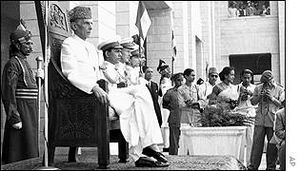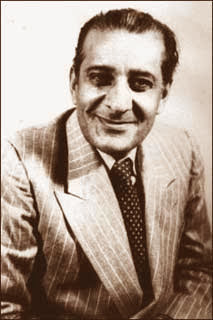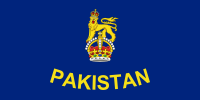Governor-General of Pakistan facts for kids
Quick facts for kids Governor-General of Pakistan |
|
|---|---|

Coat of arms of Pakistan
|
|
| Style | His Excellency |
| Residence | Governor-General's House |
| Appointer | Monarch of Pakistan |
| Formation | 14 August 1947 |
| First holder | Muhammad Ali Jinnah |
| Final holder | Iskander Mirza |
| Abolished | 23 March 1956 |
The Governor-General of Pakistan was a very important official. This person acted as the representative of the King or Queen of Pakistan. The role was created when Pakistan became an independent country in 1947. This happened because of the Indian Independence Act 1947. The office of Governor-General was ended in 1956. This was when Pakistan became an Islamic Republic and no longer had a monarch.
Contents
How the Governor-General Worked

When Pakistan first became independent, it was part of a group of countries called the Commonwealth of Nations. These countries shared the same King or Queen as their head of state. The Governor-General was the King or Queen's representative in Pakistan. The King or Queen chose the Governor-General based on advice from the Pakistani government.
The King or Queen and Pakistan's Parliament (called the Federal Legislature) worked together to make laws. The King or Queen held all the main powers to run the country. For any law to become official in Pakistan, it needed the King or Queen's approval, called "royal assent." The Governor-General gave this approval for the King or Queen.
The Governor-General also had the power to start, pause, or end meetings of the Parliament. They also chose and appointed the Council of Ministers, who were like the government's cabinet. The Governor-General could also dismiss these ministers if they wished. All Pakistani ministers held their jobs as long as the Governor-General allowed. The Governor-General of Pakistan could not be taken to court in Pakistan.
Akhilesh Pillalamarri, writing for The Diplomat magazine, said that during the time of Elizabeth II, Queen of Pakistan, "her governors-general were presidents of Pakistan in all but name." This means they had a lot of power, similar to a president.
Taking the Oath
Before starting their job, the Governor-General of Pakistan had to take an oath. This oath showed their loyalty to the Constitution of Pakistan and to the Pakistani monarch. Muhammad Ali Jinnah, the first Governor-General, took this oath:
"I, Mohammad Ali Jinnah, do solemnly affirm true faith and allegiance to the Constitution of Pakistan as by law established and that I will be faithful to His Majesty King George VI, in the office of Governor General of Pakistan."
Who Were the Governors-General?
Here is a list of the people who served as Governor-General of Pakistan:
| No. | Portrait | Name (Birth–Death) |
Term of office | Monarch (Reign) |
|||||
|---|---|---|---|---|---|---|---|---|---|
| Took office | Left office | Time in office | |||||||
| 1 |  |
Muhammad Ali Jinnah (1876–1948) |
14 August 1947 |
11 September 1948 |
1 year, 28 days | George VI (1947–1952) |
|||
| Office vacant (11 September 1948 – 14 September 1948) | |||||||||
| 2 |  |
Sir Khawaja Nazimuddin (1894–1964) |
14 September 1948 |
17 October 1951 |
3 years, 33 days | ||||
| 3 |  |
Sir Ghulam Muhammad (1895–1956) |
17 October 1951 |
7 August 1955 |
3 years, 294 days | ||||
Elizabeth II (1952–1956) |
|||||||||
| 4 |  |
Iskander Mirza (1899–1969) |
7 August 1955 |
23 March 1956 |
229 days | ||||
Flags of the Governor-General
See Also




